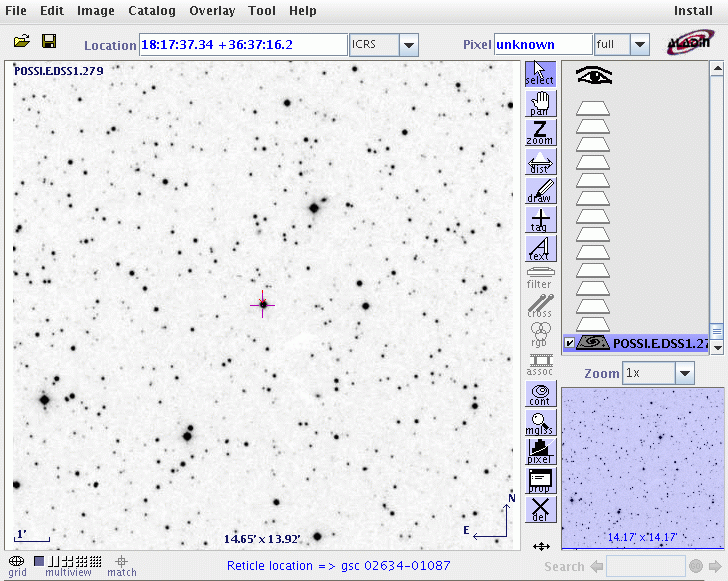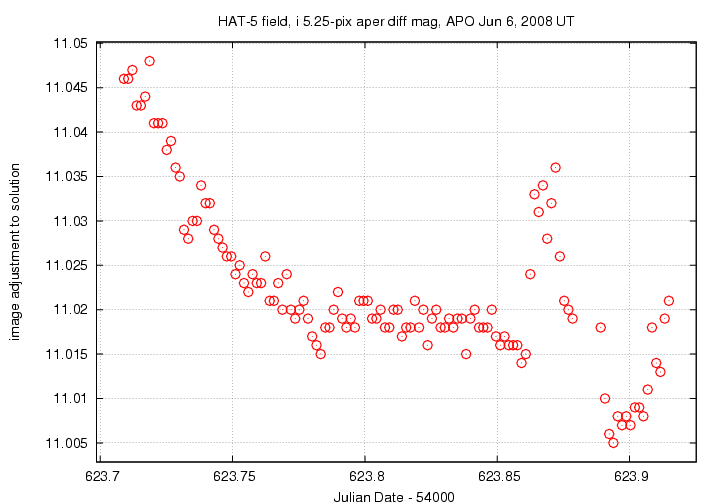
On the night of UT Jun 06, 2008, the SDSS Photometric Telescope ("PT" for short) took a series of exposures of HAT-5. We detected ingress under good conditions, at times roughly predicted by the ephemeris. We _should_ have detected egress, too, but the automatic MT pipeline didn't measure the target star during the second half of the run.
Notes from the night
This is a chart of the field. HAT-5 is the bright star indicated by the crosshairs.

The host star of HAT-5 has a magnitude V=12 according to HAT-P-5b: A Jupiter-like Hot Jupiter Transiting a Bright Star.
Following the procedures outlined by Kent Honeycutt's article on inhomogeneous ensemble photometry, I used all stars available in each image to define a reference frame, and measured each star against this frame. You can find the software package used to do the ensemble photometry online; it's free!
The night was very clear. The graph below shows the amount by which instrumental magnitudes from each image needed to be shifted to match the ensemble reference. On a clear night, this graph would show a straight horizontal line.

Below is a graph of the scatter in differential magnitude versus magnitude in the ensemble solution.

HAT-5 is the star near differential mag 1.3; it shows a small excess of scatter over neighboring stars of the same brightness. The "noise floor" in these measurements is about 0.003 mag -- very good.
Below are the light curves for the target (green symbols) and some comparison stars in the field.

In this closeup, I have shifted the data for two comparison stars to move them closer in magnitude to the target.

My eyeball estimates the ingress at 623.725.
Justin's notes indicate that the ephemeris prediction is for ingress at 623.740 -- about 22 minutes later than my visual estimate, but that's probably not significant, given the short set of pre-ingress data. The egress is predicted to occur at 623.862, during the observing run, but after the final measurement of the target star. If I go back to the original images and fiddle with mtpipe, it might be possible to recover that information.
You can grab the measurements for your own analysis. Below is a table with three flavors of time, plus the differential magnitude of the target and an estimate of the uncertainty in each measurement. I show the first few lines of the file to give you an idea of its format.
# Measurements of HAT-5 made with APO PT, Jun 6, 2008 UT. # Each exposure 55 seconds long in SDSS i-band; # Tabulated times are midexposure (FITS header time - half exposure length) # and accurate only to +/- 1 second (??). # 'mag' is a differential magnitude based on ensemble photometry # using a circular aperture of radius 5.25 arcseconds. # # UT day JD-2,450,000 HJD-2,450,000 mag uncert Jun06.70891 4623.70891 4623.71164 1.285 0.004 Jun06.71054 4623.71054 4623.71327 1.289 0.004 Jun06.71215 4623.71215 4623.71488 1.282 0.004 Jun06.71377 4623.71377 4623.71650 1.288 0.004
Last modified 06/27/2008 by MWR.